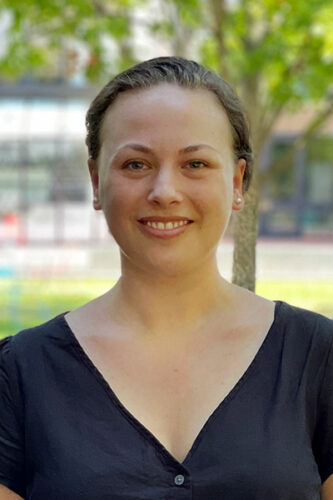Distinguished postdoctoral fellows to leverage new technology to achieve net-zero and develop energy smart ceramics
By Michele Hujber, For the Andlinger Center for Energy and the Environment
Two new Distinguished Postdoctoral Fellows have joined the Andlinger Center for Energy and the Environment. Aniruddh Mohan focuses on analyzing how emerging technologies such as electric and automated vehicles, energy storage, and direct air capture can play a role in achieving net-zero emissions. Lara Tomholt aims to develop ceramic systems that are thin enough to allow heat transfer when used in building components and manufacturing processes.
 An engineer and public policy expert, Mohan will work with Dr. Eric Larson, senior research engineer at the Andlinger Center, and Professor Jesse Jenkins, lead researchers of Princeton’s Net-Zero America study, and will be associated with the Andlinger Center’s Rapid Switch initiative. Mohan works across engineering, public policy, economics, and systems analysis to analyze how emerging technologies can contribute to deep decarbonization. His proposed research draws from his prior work in energy systems, climate policy, and transportation and will contribute to the growing body of policy-relevant research outputs from Rapid Switch, a broad research initiative investigating how to accelerate decarbonization efforts globally. According to Mohan, the “grand target” of his research is to address the need to shift to clean energy sources, whether in electricity or transportation, in an effort to move the economy to lower emissions and eventually to net-zero emissions. He is examining deployment strategies for emerging technologies, such as energy storage and automated and electric vehicles, that can maximize the benefits of environmental and large-scale energy systems.
An engineer and public policy expert, Mohan will work with Dr. Eric Larson, senior research engineer at the Andlinger Center, and Professor Jesse Jenkins, lead researchers of Princeton’s Net-Zero America study, and will be associated with the Andlinger Center’s Rapid Switch initiative. Mohan works across engineering, public policy, economics, and systems analysis to analyze how emerging technologies can contribute to deep decarbonization. His proposed research draws from his prior work in energy systems, climate policy, and transportation and will contribute to the growing body of policy-relevant research outputs from Rapid Switch, a broad research initiative investigating how to accelerate decarbonization efforts globally. According to Mohan, the “grand target” of his research is to address the need to shift to clean energy sources, whether in electricity or transportation, in an effort to move the economy to lower emissions and eventually to net-zero emissions. He is examining deployment strategies for emerging technologies, such as energy storage and automated and electric vehicles, that can maximize the benefits of environmental and large-scale energy systems.
Mohan said his research would support how policymakers address future transformations. “This work will help policymakers know where, when, and how to invest to reach net-zero emissions.”
Mohan will apply a model he developed at Carnegie Mellon University on how transportation network companies such as Uber and Lyft operate in urban environments to his work at Princeton. Using locally available data of different cities, he will expand the scope of his analysis to look at the potential impacts of future automated services and the infrastructures needed to support them. Of specific interest are the damages from greenhouse gas emissions and local air pollution from the operation of these services and how future planning for the electricity grid should account for the electrification of transportation.
Mohan will also draw on his existing analyses of U.S. freight data to better represent emerging transport technologies in macro-energy system modeling and build on the Net-Zero America project to highlight broader decarbonization strategies for the transport sector.
His work with Larson and Jenkins, assistant professor of mechanical engineering and the Andlinger Center for Energy and the Environment, will further explore the role of energy storage in decarbonizing electricity. This research intends to build upon extensive energy storage research at the Princeton’s ZERO lab and his doctoral work at Carnegie Mellon, where he used optimization techniques to study the cost targets for hybrid power plants.
 Tomholt’s research is in the area of bio-inspired sustainable building technologies. She draws inspiration from the geometry of plant leaves, looking for designed ceramic systems that maximize surface area, minimize thickness, and provide internal channels for increased heat transfer through fluid flow, as plant leaves do. This is achieved by advanced manufacturing processes such as robotic additive manufacturing and 3D printing.
Tomholt’s research is in the area of bio-inspired sustainable building technologies. She draws inspiration from the geometry of plant leaves, looking for designed ceramic systems that maximize surface area, minimize thickness, and provide internal channels for increased heat transfer through fluid flow, as plant leaves do. This is achieved by advanced manufacturing processes such as robotic additive manufacturing and 3D printing.
The building industry accepts structural ceramics such as concrete and sustainable binders as suitable materials for the environmental regulation of buildings. However, ceramics are notoriously brittle, and the ability to design and fabricate them efficiently and autonomously is lacking. Plant leaves have an efficient internal vascular network that transports water and nutrients, hinting at how ceramic systems might transport hot and cool air or water. Furthermore, leaf geometry contributes to its structural support, an element Tomholt would like to incorporate into thinner structural ceramics.
At Princeton, Tomholt will work with Reza Moini, assistant professor of civil and environmental engineering, on work related to materials science, bio-inspired and architected materials, and additive manufacturing. She will explore new materials design and additive manufacturing processes that can produce thinner and thermally efficient ceramics. Several avenues of research are critical for advancing her goals. These include experimental and modeling studies of the material properties for target designs having thin, high-effective surface areas that can effectively transfer heat while maintaining their structural integrity. For designs that perform well, Tomholt will then develop novel additive manufacturing approaches for fabrication, taking into account which combinations of ceramics would be most suitable and what additional materials or geometries can be integrated to accelerate heat transfer or evaporative cooling.
Tomholt will study a selection of plant leaves that exhibit sizeable surface areas, such as the “folded” Australian fan palm. Using lessons learned from nature, she intends to design ceramic systems and produce them with layer-by-layer manufacturing, and then study how to incorporate them into building facades or building interiors. Research related to building thermoregulation will involve additional collaboration with Forrest Meggers, associate professor of architecture and the Andlinger Center for Energy and the Environment. She expects her work to lead new, more sustainable approaches to thermoregulate buildings.
“There is an urgent need to reduce energy by finding new, more energy-efficient ways to heat and cool our buildings,” Hombolt said. “It is essential to curb climate change.”